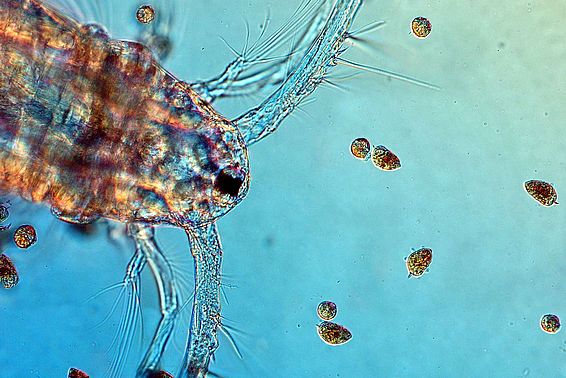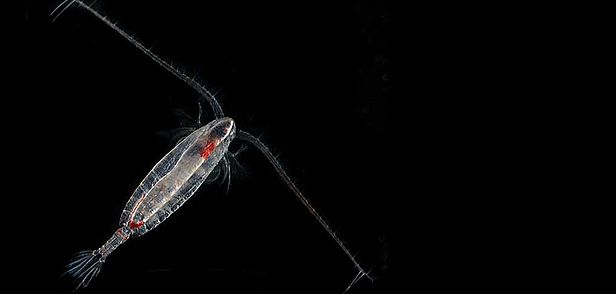26.02.2019 | Birgit Ottmer | News WSL
Tiny marine organisms transport huge amounts of carbon from the atmosphere to the depths of the oceans, where it is deposited and thus removed from the atmosphere over the long term. A new study now shows that this process is being significantly altered by climate change, at least in the North Atlantic.
In the global carbon cycle, oceans play an important role as so-called carbon sinks: on the one hand, carbon dioxide is chemically bound, and on the other, plankton absorbs it from the air through photosynthesis. Tiny little animals, known as zooplankton, eat the plant plankton. To avoid being eaten by fish or other predators, many species of zooplankton hide in deep, dark ocean layers during the day. Some species also hibernate in even deeper layers. There, they release carbon dioxide through respiration, but this carbon dioxide remains bound in the deep water layers. In addition, their faecal matter, in which carbon is also bound, sinks to the ocean floor. All these processes are part of the "biological pump" which removes approximately the same amount of carbon from the atmosphere as we humans are currently releasing into it. It is therefore an important process that buffers the greenhouse effect.
In a recently published study, environmental scientist Philipp Brun, who currently works at the WSL, together with colleagues from Denmark, the USA, Great Britain and Italy, has demonstrated that climate change has significantly altered this pump in the North Atlantic; the centres of the carbon sinks are shifting towards the north-west. Between Iceland and the Gulf of Maine, more carbon is now being bound than before, but transport in the open North Atlantic has decreased.
Copepods are relocated
In their study, the researchers focussed on the zooplankton group known as copepods (see image). They are important predators of plant plankton in the North Atlantic, and there are long observation series on their distribution and frequency. Although individual animals are only as large as a grain of rice at most (body length ranges from 0.3 to 7 mm), they are key contributors to the carbon pump due to their extreme abundance. In their study, the scientists combined observational data on the temporal and spatial distribution of copepods over the past 60 years with theoretical considerations and calculations on how carbon reaches the depths of the oceans through migration, respiration, faeces or the death of the animals. The results: Changing temperature conditions in the North Atlantic led many species to shift the centre of their distribution area towards the poles, and the species composition changed. Accordingly, the main activity of the biological pump shifted to the northwest.
Philipp Brun comments: "Our data were not sufficient to estimate changes in the pump’s performance across the North Atlantic basin; however, we were able to demonstrate that the climate change-induced shifts in the distribution of important species have led to considerable regional changes in carbon export. It is important that we continue to monitor these processes closely."
The calculations by Philipp Brun and his colleagues can also be applied to other oceans and could be incorporated into models that simulate global carbon flux.
Contact
Links and documents
Copyright
WSL and SLF provide image and sound material free of charge for use in the context of press contributions in connection with this media release. The transfer of this material to image, sound and/or video databases and the sale of the material by third parties are not permitted.


